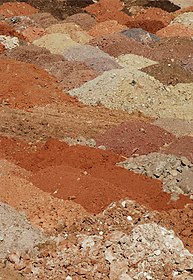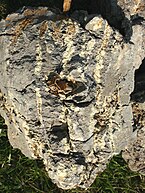Soil color

Soil color is often the most visually apparent property of soil. While color itself does not influence the behavior or practical use of soils,[1] it does indicate important information about the soil organic matter content, mineralogy, moisture, and drainage.[2]
Soil can display a wide range of colors including brown, red, yellow, black, gray, white, and even blue or green, and vary dramatically across landscapes, between the various horizons of a soil profile, and even within a single clod of soil.[1]
The development and distribution of color in soil results from chemical and biological weathering, especially redox reactions. As the primary minerals in soil parent material weather, the elements combine into new and colorful compounds. Soil conditions produce uniform or gradual color changes, while reducing environments result in disrupted color flow with complex, mottled patterns and points of color concentration. Sometimes, a distinct change in color within a soil profile indicates a change in the soil parent material or mineral origin.[3]
Causes
[edit]Dark brown or black
[edit]
Dark brown or black colors typically indicate that the soil has a high organic matter content.[4] Organic matter coats mineral soil particles, which masks or darkens the natural mineral colors.[1]
Sodium content also influences the depth of organic matter and therefore the soil color. Sodium causes organic matter particles such as humus to disperse more readily and reach more minerals.[5] Additionally, soils which accumulate charcoal exhibit a black color.[6][7]
Red
[edit]
Red colors often indicate iron accumulation or oxidation in oxygen-rich, well-aerated soils.[4] Iron concentrations caused by redox reactions because of diffusion of iron in crystalline and metermorphic rock,in periodically saturated soils may also present red colors, particularly along root channels or pores.[8]
Gray or blue
[edit]Soil in anaerobic, saturated environments may appear gray or blue in color due to the redox reduction and/or depletion of iron. In an anaerobic soils, microbes reduce iron from the ferric (Fe3+) to the ferrous (Fe2+) form. Manganese may also be reduced from the manganic (Mn4+) to the manganous (Mn2+) form, though iron reduction is more common in soil.[8] The reduced iron compounds cause poorly drained soil to appear gray or blue, and because reduced iron is soluble in water, it may be removed from the soil during prolonged saturation. This often exposes the light gray colors of bare silicate minerals, and soils with a low chroma from iron reduction or depletion are said to be gleyed.[1]
Green
[edit]
Iron reduction may impart greenish gray colors, though certain minerals including glauconite, melanterite, and celadonite can also give soil a green color. Glauconite soils form from select marine sedimentary rocks, while melanterite soils are produced in acidic, pyrite-rich soils.[9][10] Celadonite in hydrothermally-altered basalt within the Mojave Desert has been observed to weather into a green colored smectite-rich clay soil.[11][12]
Yellow
[edit]
Yellow soils may indicate iron accumulation as well, though in less oxygen-rich environments than red soils.[4] Jarosite accumulation can also create yellow soil color and may be found in salt marshes, sulfide ore deposits, acid mine tailings, and other acidic soils.[13][14]
White
[edit]White colors are common in soils with salt, carbonate, or calcite accumulations, which often occur in arid environments.[3][15]

Description
[edit]Most soil survey organizations utilize the Munsell color system to decrease the subjectivity in evaluating color.[13] This system was developed by Albert Munsell, a painter, in the early 20th century to describe the full-color spectrum, though the specially adapted Munsell soil color books commonly used by soil scientists only include the most relevant colors for soil.[16]
The Munsell color system includes the following three components:[1]
- Hue: indicates the dominant spectral (i.e., rainbow) color, which in the soil is generally yellow or red. Each page of the Munsell soil color book displays a different hue. Examples include 10YR, 5YR, and 2.5Y.
- Value: indicates lightness or darkness. The value increases from the bottom of each page to the top, with lower numbers representing darker colors. Color with a value of 0 would be black.
- Chroma: indicates intensity or brightness. Chroma increases from left to right on each page, with higher numbers representing more vivid or saturated colors. Color with a chroma of 0 would be neutral gray.
A general color name, such as yellowish brown or light gray, often accompanies the Munsell notation for soil samples. These qualitative descriptors correspond to one or more color chips in the Munsell soil color books; however, they are not formally part of the broader Munsell color system.[13]
Because soil color (specifically the value) varies with moisture, it may be described at both its moist and dry state. Soil is considered moist when adding water no longer changes the soil color or as "dry" when the soil is air dry.[17]
See also
[edit]References
[edit]- ^ a b c d e Brady, Nyle C.; Weil, Ray R. (2010). Elements of the nature and properties of soils (3rd ed.). Upper Saddle River, N.J. ISBN 978-0-13-501433-2. OCLC 276340542.
{{cite book}}: CS1 maint: location missing publisher (link) - ^ Owens, P. R.; Rutledge, E. M. (2005). Encyclopedia of soils in the environment. Daniel Hillel, Jerry L. Hatfield (1st ed.). Oxford, UK: Elsevier/Academic Press. ISBN 0-12-348530-4. OCLC 52486575.
- ^ a b Gardiner, Duane T.; Miller, Raymond W. (2008). Soils in our environment (11th ed.). Upper Saddle River, N.J.: Pearson/Prentice Hall. ISBN 978-0-13-219104-3. OCLC 85018836.
- ^ a b c Singer, Michael J.; Munns, Donald N. (2006). Soils : an introduction (6th ed.). Upper Saddle River, N.J.: Pearson Prentice Hall. ISBN 0-13-119019-9. OCLC 57506906.
- ^ "Interpreting Soil Colour". Victorian Resources Online. Retrieved 15 January 2017.
- ^ Krug, Edward C.; Hollinger, Steven E. (2003). "Identification of Factors that Aid Carbon Sequestration in Illinois Agricultural Systems" (PDF). Champaign, Illinois: Illinois State Water Survey. p. 10. Archived from the original (PDF) on 2017-08-09. Retrieved 2019-01-06.
While humus (especially in organomineral form) helps give soils a black color (Duchaufour, 1978), the literature shows correlation between forest and grassland soil color to BC - the blacker the soil the higher its BC content (Schmidt and Noack, 2000)
- ^ Gonzalez-Perez, Jose A.; Gonzalez-Vila, Francisco J.; Almendros, Gonzalo; Knicker, Heike (2004). "The effect of fire on soil organic matter-a review" (PDF). Environment International. 30 (6). Elsevier: 855–870. doi:10.1016/j.envint.2004.02.003. PMID 15120204. Retrieved 2019-01-04.
As a whole, BC represents between 1 and 6% of the total soil organic carbon. It can reach 35% like in Terra Preta Oxisols (Brazilian Amazonia) (Glaser et al., 1998, 2000) up to 45 % in some chernozemic soils from Germany (Schmidt et al., 1999) and up to 60% in a black Chernozem from Canada (Saskatchewan) (Ponomarenko and Anderson, 1999)
- ^ a b United States Department of Agriculture, Natural Resources Conservation Service. 2018. Field Indicators of Hydric Soils in the United States, Version 8.2. L.M. Vasilas, G.W. Hurt, and J.F. Berkowitz (eds.). USDA, NRCS, in cooperation with the National Technical Committee for Hydric Soils. https://www.nrcs.usda.gov/sites/default/files/2022-09/Field_Indicators_of_Hydric_Soils.pdf
- ^ Wurman, Eliahu (1960). "A mineralogical study of a gray-brown podzolic soil in Wisconsin derived from glauconitic sandstone". Soil Science. 89 (1): 38–44. Bibcode:1960SoilS..89...38W. doi:10.1097/00010694-196001000-00007. ISSN 0038-075X. S2CID 128889991.
- ^ Frau, F. (December 2000). "The formation-dissolution-precipitation cycle of melanterite at the abandoned pyrite mine of Genna Luas in Sardinia, Italy: environmental implications". Mineralogical Magazine. 64 (6): 995–1006. Bibcode:2000MinM...64..995F. doi:10.1180/002646100550001. ISSN 0026-461X. S2CID 129237832.
- ^ Reid, D. A.; Graham, R. C.; Edinger, S. B.; Bowen, L. H.; Ervin, J. O. (1988-10-01). "Celadonite and its Transformation to Smectite in an Entisol at Red Rock Canyon, Kern County, California". Clays and Clay Minerals. 36 (5): 425–431. Bibcode:1988CCM....36..425R. doi:10.1346/CCMN.1988.0360507. ISSN 1552-8367. S2CID 55931277.
- ^ Velde, B. (2003-01-01), Holland, Heinrich D.; Turekian, Karl K. (eds.), "7.12 - Green Clay Minerals", Treatise on Geochemistry, 7, Oxford: Pergamon: 309–324, Bibcode:2003TrGeo...7..309V, doi:10.1016/b0-08-043751-6/07090-0, ISBN 978-0-08-043751-4, retrieved 2023-05-05
- ^ a b c Soil Science Division Staff. 2017. Soil survey manual. C. Ditzler, K. Scheffe, and H.C. Monger (eds.). USDA Handbook 18. Government Printing Office, Washington, D.C., USA. https://www.nrcs.usda.gov/sites/default/files/2022-09/The-Soil-Survey-Manual.pdf
- ^ Cogram, Peter (2018-01-01), "Jarosite", Reference Module in Earth Systems and Environmental Sciences, Elsevier, doi:10.1016/b978-0-12-409548-9.10960-1, ISBN 978-0-12-409548-9, retrieved 2023-04-18
- ^ Brady, Nyle C. & Ray R. Weil Elements of the Nature and Properties of Soils, page 95. Prentice Hall, 2006.
- ^ Owens, P. R.; Rutledge, E. M. (2005). Encyclopedia of soils in the environment. Daniel Hillel, Jerry L. Hatfield (1st ed.). Oxford, UK: Elsevier/Academic Press. p. 514. ISBN 0-12-348530-4. OCLC 52486575.
- ^ Buol, S. W. (2011). Soil genesis and classification. R. J. Southard, R. C. Graham, P. A. McDaniel (6th ed.). Chichester, West Sussex. ISBN 978-0-470-96062-2. OCLC 747546196.
{{cite book}}: CS1 maint: location missing publisher (link)
Further reading
[edit]- "The Color of Soil". United States Department of Agriculture - Natural Resources Conservation Service. Archived from the original on 2007-10-27. Retrieved 2007-11-25.
- "Soil Color Contrast". United States Department of Agriculture - Natural Resources Conservation Service. Archived from the original on 2007-11-12. Retrieved 2007-11-25.
- "Why is the ground brown". Retrieved 2007-11-25.

